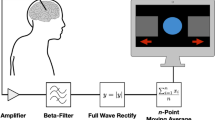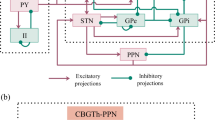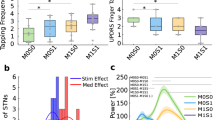Abstract
Cortical information has great importance to reflect the deep brain stimulation (DBS) effects for Parkinson’s disease patients. Using cortical activities to feedback is an available closed-loop idea for DBS. Previous studies have demonstrated the pathological beta (12–35 Hz) cortical oscillations can be suppressed by appropriate DBS settings. Thus, here we propose to close the loop of DBS based on the beta oscillations in cortex. By modify the cortico-basal ganglia-thalamic neural loop model, more biologically realistic underlying the Parkinsonian phenomenon is approached. Stimulation results show the proposed closed-loop DBS strategy using cortical beta oscillation as feedback information has more profound roles in alleviating the pathological neural abnormality than the traditional open-loop DBS. Additionally, we compare the stimulation effects with subthalamic nucleus feedback strategy. It is shown that using cortical beta information as the feedback signals can further enlarge the control parameter space based on proportional-integral control structure with a lower energy expenditure. This work may pave the way to optimizing the DBS effects in a closed-loop arrangement.









Similar content being viewed by others
References
Boraud T, Bezard E, Guehl D, Bioulac B, Gross C (1998) Effects of L-DOPA on neuronal activity of the globus pallidus externalis (GPe) and globus pallidus internalis (GPi) in the MPTP-treated monkey. Brain Res 787(15):157–160
Butson CR, McIntyre CC (2007) Differences among implanted pulse generator waveforms cause variations in the neural response to deep brain stimulation. Clin Neurophysiol 118(14):1889–1894
Cao C, Zeng K, Li D, Zhan S, Li X, Sun B (2017) Modulations on cortical oscillations by subthalamic deep brain stimulation in patients with Parkinson disease: a MEG study. Neurosci Lett 636(12):95–100
Carron R, Chaillet A, Filipchuk A, Pasillas-Lépine W, Hammond C (2013) Closing the loop of deep brain stimulation. Front Syst Neurosci 7:112
Dayal V, Limousin P, Foltynie T (2017) Subthalamic nucleus deep brain stimulation in Parkinson’s disease: the effect of varying stimulation parameters. J Parkinsons Dis 7(1):235–245
Detorakis GI, Chaillet A, Palfi S, Senova S (2015) Closed-loop stimulation of a delayed neural fields model of parkinsonian STN-GPe network: a theoretical and computational study. Front Neurosci 9:237
Eusebio A, Thevathasan W, Gaynor LD et al (2011) Deep brain stimulation can suppress pathological synchronisation in parkinsonian patients. J Neurol Neurosurg Psychiatry 82(2):569–573
Gorzelic P, Schiff SJ, Sinha A (2013) Model-based rational feedback controller design for closed-loop deep brain stimulation of Parkinson’s disease. J Neural Eng 10(2):026016
Haber SN (2003) The primate basal ganglia: parallel and integrative networks. J Chem Neuroanat 26(8):317–330
Hashimoto T, Elder CM, Okun MS, Patrick SK, Vitek JL (2003) Stimulation of the subthalamic nucleus changes the firing pattern of pallidal neurons. J Neurosci 23(5):1916–1923
Hodgkin AL, Huxley AF (1952) A quantitative description of membrane current and its application to conduction and excitation in nerve. J Physiol 117(5):500–544
Holt AB, Netoff TI (2014) Origins and suppression of oscillations in a computational model of Parkinson’s disease. J Comput Neurosci 37:505–521
Izhikevich EM (2003) Simple model of spiking neurons. IEEE Trans Neural Netw 14:1569–1572
Little S, Pogosyan A, Neal S, Zavala B, Zrinzo L, Hariz M, Foltynie T, Limousin P, Ashkan A, FitzGerald J, Green AL, Aziz TZ, Brown P (2013) Adaptive deep brain stimulation in advanced Parkinson disease. Ann Neurol 74(3):449–457
Liu C, Wang J, Chen Y, Deng B, Wei X, Li H (2013) Closed-loop control of the thalamocortical relay neuron’s Parkinsonian state based on slow variable. Int J Neural Syst 23(4):1350017
Liu C, Wang J, Deng B, Wei X, Yu H, Li H (2015) Variable universe fuzzy closed-loop control of tremor predominant Parkinsonian state based on parameter estimation. Neurocomputing 151(11):1507–1518
Liu C, Wang J, Deng B, Wei X, Yu H, Li H, Fietkiewicz C, Loparo KA (2016a) Closed-loop control of tremor-predominant Parkinsonian state based on parameter estimation. IEEE Trans Neural Syst Rehabil Eng 24:1109–1121
Liu C, Wang J, Li H, Lu M, Deng B, Yu H, Wei X, Fietkiewicz C, Loparo KA (2016b) Closed-loop modulation of the pathological disorders of the basal ganglia network. IEEE Trans Neural Netw Learn Syst 28(5):371–382
Liu C, Wang J, Li H, Fietkiewicz C, Loparo KA (2018) Modeling and analysis of beta oscillations in the basal ganglia. IEEE Trans Neural Netw Learn Syst 29(2):1864–1875
Lu M, Wei X, Loparo KA (2017) Investigating synchronous oscillation and deep brain stimulation treatment in a model of cortico-basal ganglia network. IEEE Trans Neural Syst Rehabil Eng 25(3):1950–1958
Mallet N, Pogosyan A, Sharott A, Csicsvari J, Bolam JP, Brown P, Magill PJ (2008) Disrupted dopamine transmission and the emergence of exaggerated beta oscillations in subthalamic nucleus and cerebral cortex. J Neurosci 28(3):4795–4806
Miocinovic S, Somayajula S, Chitnis S, Vitek JL (2013) History, applications, and mechanisms of deep brain stimulation. JAMA Neurol 70(5):163–171
Oswal A, Beudel M, Zrinzo L, Limousin P, Hariz M, Foltynie T, Litvak V, Brown P (2016) Deep brain stimulation modulates synchrony within spatially and spectrally distinct resting state networks in Parkinson’s disease. Brain 139(11):1482–1496
Popovych OV, Lysyansky B, Rosenblum M, Pikovsky A, Tass PA (2017) Pulsatile desynchronizing delayed feedback for closed-loop deep brain stimulation. PLoS ONE 3(1):1–29
Rubin JE, Terman D (2004) High frequency stimulation of the subthalamic nucleus eliminates pathological thalamic rhythmicity in a computational model. J Comput Neurosci 16(3):211–235
Sharott A, Gulberti A, Hamel WJ et al (2018) Spatio-temporal dynamics of cortical drive to human subthalamic nucleus neurons in Parkinson’s disease. Neurobiol Dis 112(3):49–62
Stefani A, Trendafifilov V, Liguori C, Fedele E, Galati S (2017a) Subthalamic nucleus deep brain stimulation on motor-symptoms of Parkinson’s disease: focus on neurochemistry. Prog Neurobiol 151:157–174
Stefani A, Trendafilov V, Liguori C et al (2017b) Subthalamic nucleus deep brain stimulation on motor-symptoms of Parkinson’s disease: focus on neurochemistry. Prog Neurobiol 151(8):157–174
Steigerwald F, Potter M, Herzog J, Pinsker M, Kopper F, Mehdorn H, Deuschl G, Volkmann J (2008) Neuronal activity of the human subthalamic nucleus in the Parkinsonian and Nonparkinsonian State. J Neurophysiol 100(17):2515–2524
Steigerwald F, Müller L, Johannes S, Matthies C, Volkmann J (2016) Directional deep brain stimulation of the subthalamic nucleus: a pilot study using a novel neurostimulation device. Movement Disord 31(4):1240–1243
Swann NC, Hemptinne C, Thompson MC, Miocinovic S, Miller AM et al (2018) Adaptive deep brain stimulation for Parkinson’s disease using motor cortex sensing. J Neural Eng 15(7):046006
Terman D, Rubin JE, Yew AC, Wilson CJ (2002) Activity patterns in a model for the subthalamopallidal network of the basal ganglia. J Neurosci 22(1):2963–2976
Thibeault CM, Srinivasa N (2013) Using a hybrid neuron in physiologically inspired models of the basal ganglia. Front Comput Neurosci 7(1):88
Volkmann J, Herzog J, Kopper F, Deuschl GN (2002) Introduction to the programming of deep brain stimulators. Movement Disord 17(8):181–187
Voytek B (2006) Emergent basal ganglia pathology within computational models. J Neurosci 26(28):7317–7318
Wang Z, Wang R (2014) Energy distribution property and energy coding of a structural neural network. Front Comput Neurosci 8(2):00014
Wang R, Wang Z (2018) The essence of neuronal activity from the consistency of two different neuron models. Nonlinear Dyn 92(11):973–982
Wang R, Tsuda I, Zhang Z (2015) A new work mechanism on neuronal activity. Int J Neural Syst 25(7):1450037
Weiss D, Klotz R, Govindan RB, Scholten M et al (2015) Subthalamic stimulation modulates cortical motor network activity and synchronization in Parkinson’s disease. Brain 138(4):679–693
Wongsarnpigoon A, Grill WM (2010) Energy-efficient waveform shapes for neural stimulation revealed with a genetic algorithm. J Neural Eng 7(3):046009
Yu Y, Hao Y, Wang Q (2020) Model-based optimized phase-deviation deep brain stimulation for Parkinson ’s disease. Neural Netw 122(15):308–319
Zhu Z, Wang R, Zhu F (2018) The energy coding of a structural neural network based on the Hodgkin-Huxley model. Front Neurosci 12(3):00122
Acknowledgements
This work was supported by the Natural Science Foundation of Tianjin, China (Grant Nos. 20JCQNJC01160 and 18JCZDJC32000) and the Foundation of Tianjin University under Grant 2020XRG-0018. The authors also gratefully acknowledge the financial support provided by Opening Fundation of Key Laboratory of Opto-technology and Intelligent Control (Lanzhou Jiaotong University), Ministry of Education (KFKT2020-01).
Author information
Authors and Affiliations
Corresponding author
Additional information
Publisher's Note
Springer Nature remains neutral with regard to jurisdictional claims in published maps and institutional affiliations.
Rights and permissions
About this article
Cite this article
Liu, C., Zhao, G., Meng, Z. et al. Closing the loop of DBS using the beta oscillations in cortex. Cogn Neurodyn 15, 1157–1167 (2021). https://doi.org/10.1007/s11571-021-09690-1
Received:
Revised:
Accepted:
Published:
Issue Date:
DOI: https://doi.org/10.1007/s11571-021-09690-1




